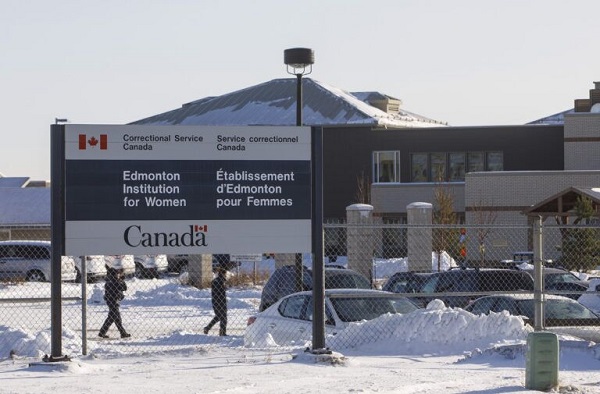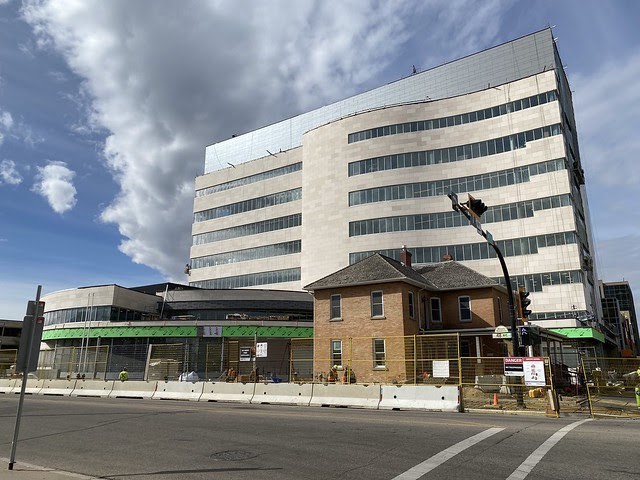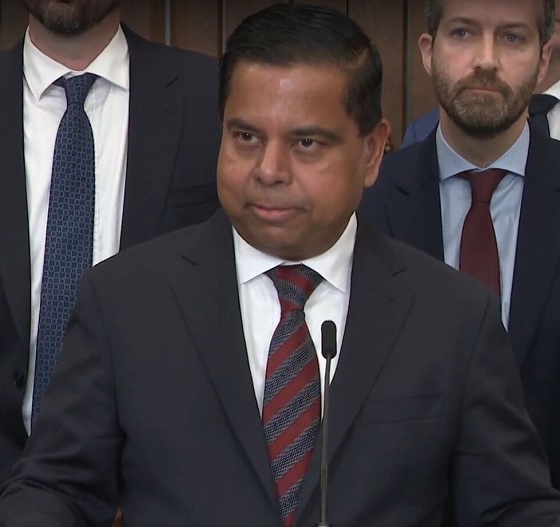Justice
Canadian government sued for forcing women to share spaces with ‘transgender’ male prisoners

The Edmonton Institution for Women, one of six women’s corrections facilities in Canada (Photo credit: The Canadian Press/Jason Franson)
The Justice Centre for Constitutional Freedoms announces that a lawsuit has been launched against the Federal Government, seeking an end to the practice of forcibly confining female inmates of federal prisons with trans-identifying male inmates. The lawsuit claims that this practice is cruel and unusual punishment and violates the Charter rights of female inmates, including “their right to be protected from mental, physical, and sexual abuse…”
The lawsuit was filed on behalf of the national and non-partisan organization Canadian Women’s Sex-Based Rights (CAWSBAR) with the Federal Court of Canada in Toronto on April 7, 2025.
Since 2019, CAWSBAR has advocated for a Canada “where women and girls can be assured that their sex-based rights to bodily privacy ,dignity, fairness, and security are upheld both in law and in public policy.”
Their lawsuit takes aim at the Correctional Service Canada’s Commissioner’s Directive 100: Gender Diverse Offenders, which permits the practice of transferring trans-identifying male inmates to any of six women’s prisons across Canada. CAWSBAR is asking the Federal Court to declare that this Directive is of no force or effect.
Their lawsuit references an extensive list of physical and psychological harms female inmates have suffered as a result of being forcibly confined with trans-identifying male prisoners, including sexual assaults, sexual harassment, beatings, stalking, and grooming.
Many female prisoners come from disadvantaged backgrounds that often include past physical and sexual abuse from males. The current practice of having both males and females attend the same group therapy sessions makes it difficult for female inmates to fully participate in the treatment they seek. In advancing CASWBAR’s claim, lawyers will provide the court with evidence of psychological and physical harms that often lead to Post Traumatic Stress Disorder, flashbacks of stressful violent and/or emotionally disturbing events involving men, anxiety, anger, depression, hopelessness, and suicidality.
Female inmates are reluctant to complain about these arrangements. The court document states that complaints “are often viewed by correctional officers and staff as harassment, intolerance, and/or ‘transphobia.’ Female inmates do not speak out for fear of an entry on their institutional record, which will eventually be considered by the Parole Board of Canada, and which could impact the decision to grant or not grant parole.”
CAWSBAR is not the first organization to report on the risks associated with forcibly confining female inmates alongside trans-identifying males. According to 2023 research from the Macdonald-Laurier Institute, “More than 90% (55 of 61) of [trans-identified male] prisoners were incarcerated for violent offences. Of the group, nearly half (25) had a most serious offence that was homicide related and a third (18) had a most serious offense that was sexual in nature. In comparison, fewer than three-in-10 (6 of 21) [trans-identified females] were convicted of homicide related offences. This proportion of [trans-identified males] incarcerated for sexual and homicide-related offences is extraordinarily high compared to the general female prison population.”
Prior to 2017, only males who had completed sex reassignment surgery could be transferred to a women’s prison.
In October 2016, however, Parliament passed Bill-16, which amended the Canadian Human Rights Act to include gender identity and gender expression as prohibited grounds of discrimination. The Corrections and Conditional Release Act was also amended to include gender identity and expression as prohibited grounds of discrimination. Bill-16 became law on June 19, 2017, and Correctional Service Canada responded by drafting policies that authorized the transfer into women’s prisons of males who identify as women but have not necessarily undergone any surgical transitions.
The current policy, Commissioner’s directive 100: Gender diverse offenders, came into effect in May 2022.
CAWSBAR’s lawsuit argues that the current practice violates the constitutionally protected rights of female inmates. Section 7 of the Canadian Charter of Rights and Freedoms guarantees female inmates the right to life, liberty, and security of the person. Section 12 guarantees the right not to be subjected to any cruel and unusual treatment. Section 15 guarantees equality before and under the law as well as the right not to be discriminated against on the basis of sex.
Their lawsuit also references section 28, which reads, “Notwithstanding anything in this Charter, the rights and freedoms referred to in it are guaranteed equally to male and female persons.”
Heather Mason is a CAWSBAR board member and former inmate at the Grand Valley Institution for Women in Kitchener, Ontario. She explained the reason for her organization’s involvement and her personal motivation. “We initiated this action,” she stated, “to highlight the federal government’s failure to protect women and to raise public awareness about the cruel and unusual punishment that incarcerated women endure as a result of this transfer policy,” she says.
“This matter is especially important to me as a former federal prisoner,” Ms. Mason continued, “I firmly believe that all women are entitled to sex-based rights and protections as specified in the Canadian Charter of Rights and Freedoms.”
John Carpay, President of the Justice Centre, stated, “This lawsuit is a pivotal stand for the safety and dignity of female inmates, challenging a policy that disregards their Charter-protected rights and exposes them to intolerable harm. It underscores the urgent need to prioritize the security of vulnerable women over ideological directives.”
Censorship Industrial Complex
Legal warning sent to Ontario school board for suspending elected school council member

The Justice Centre for Constitutional Freedoms announces that a legal warning letter has been sent to the Hamilton-Wentworth District School Board after it suspended a parent from her role on the School Council for respectfully objecting to land acknowledgements.
Catherine Kronas, a concerned parent with a child enrolled at Ancaster High Secondary School, was re-elected to serve on School Council in October 2024.
During a Council meeting on April 9, 2025, Ms. Kronas asked that her respectful objection to land acknowledgements be noted in the minutes. No disruption occurred; her comments were limited to requesting that her dissenting viewpoint be recorded.
On May 22, 2025, however, the School Board informed Ms. Kronas that her involvement on the Council was being “paused” based on allegations that she had caused harm and had violated a Code of Conduct Policy. She has not been permitted to attend the next scheduled meeting.
Ms. Kronas was unsettled by the Board’s decision, saying, “I was taken aback by the Board’s decision to suspend me from the School Council after delivering a respectful objection, especially given assurances made at a previous council meeting and outlined in the Council bylaws that open dialogue and diverse perspectives are welcomed.”
“By barring me from the next meeting, the Council sends a troubling message to all parents: that even respectful disagreement may be met not with dialogue, but with disciplinary action. I am grateful to the Justice Centre for Constitutional Freedoms for assisting me in this matter,” she remarked.
Constitutional lawyer Hatim Kheir said Ms. Kronas’ comments “were a reasonable and measured expression of a viewpoint held by many Canadians.”
“The Board’s decision to suspend her from the Council, which she has a right to sit on as an elected parent member, is an act of censorship that offends the right to freedom of expression,” he explained.
Mr. Kheir is calling for Ms. Kronas to be immediately reinstated to the Council and to be allowed to fulfill her elected role without further retaliation for expressing her views.
To view a brief video summary of this matter, click here.
To receive regular updates from the Justice Centre, click on this link to join our email list.
Alberta
Red Deer Justice Centre Grand Opening: Building access to justice for Albertans

The new Red Deer Justice Centre will help Albertans resolve their legal matters faster.
Albertans deserve to have access to a fair, accessible and transparent justice system. Modernizing Alberta’s courthouse infrastructure will help make sure Alberta’s justice system runs efficiently and meets the needs of the province’s growing population.
Alberta’s government has invested $191 million to build the new Red Deer Justice Centre, increasing the number of courtrooms from eight to 12, allowing more cases to be heard at one time.
“Modern, accessible courthouses and streamlined services not only strengthen our justice
system – they build safer, stronger communities across the province. Investing in the new Red Deer Justice Centre is vital to helping our justice system operate more efficiently, and will give people in Red Deer and across central Alberta better access to justice.”

Government of Alberta and Judiciary representatives with special guests at the Red Deer Justice Centre plaque unveiling event April 22, 2025.
On March 3, all court services in Red Deer began operating out of the new justice centre. The new justice centre has 12 courtrooms fully built and equipped with video-conference equipment to allow witnesses to attend remotely if they cannot travel, and vulnerable witnesses to testify from outside the courtroom.
The new justice centre also has spaces for people taking alternative approaches to the traditional courtroom trial process, with the three new suites for judicial dispute resolution services, a specific suite for other dispute resolution services, such as family mediation and civil mediation, and a new Indigenous courtroom with dedicated venting for smudging purposes.
“We are very excited about this new courthouse for central Alberta. Investing in the places where people seek justice shows respect for the rights of all Albertans. The Red Deer Justice Centre fills a significant infrastructure need for this rapidly growing part of the province. It is also an important symbol of the rule of law, meaning that none of us are above the law, and there is an independent judiciary to decide disputes. This is essential for a healthy functioning democracy.”
“Public safety and access to justice go hand in hand. With this investment in the new Red Deer Justice Centre, Alberta’s government is ensuring that communities are safer, legal matters are resolved more efficiently and all Albertans get the support they need.”
“This state-of-the-art facility will serve the people of Red Deer and surrounding communities for generations. Our team at Infrastructure is incredibly proud of the work done to plan, design and build this project. I want to thank everyone, at all levels, who helped make this project a reality.”
Budget 2025 is meeting the challenge faced by Alberta with continued investments in education and health, lower taxes for families and a focus on the economy.

Quick facts
- The new Red Deer Justice Centre is 312,000 sq ft (29,000 m2). (The old courthouse is 98,780 sq ft (9,177 m2)).
- The approved project funding for the Red Deer Justice Centre is about $191 million.
-

 International12 hours ago
International12 hours agoIsrael’s Decapitation Strike on Iran Reverberates Across Global Flashpoints
-

 Business1 day ago
Business1 day agoThe carbon tax’s last stand – and what comes after
-

 Business22 hours ago
Business22 hours agoTrump: ‘Changes are coming’ to aggressive immigration policy after business complaints
-

 International1 day ago
International1 day agoPentagon agency to simulate lockdowns, mass vaccinations, public compliance messaging
-

 Business2 days ago
Business2 days agoJustice Centre launches new petition: Keep cash legal and accessible. Stop Bill C-2
-

 illegal immigration21 hours ago
illegal immigration21 hours agoLA protests continue as judge pulls back CA National Guard ahead of ‘No Kings Day’
-

 Business1 day ago
Business1 day agoOur addiction to dairy supply management is turning Canada into a trade pariah
-

 Alberta1 day ago
Alberta1 day agoOil prices are headed for a hard fall






